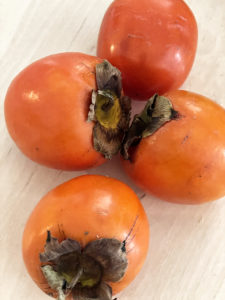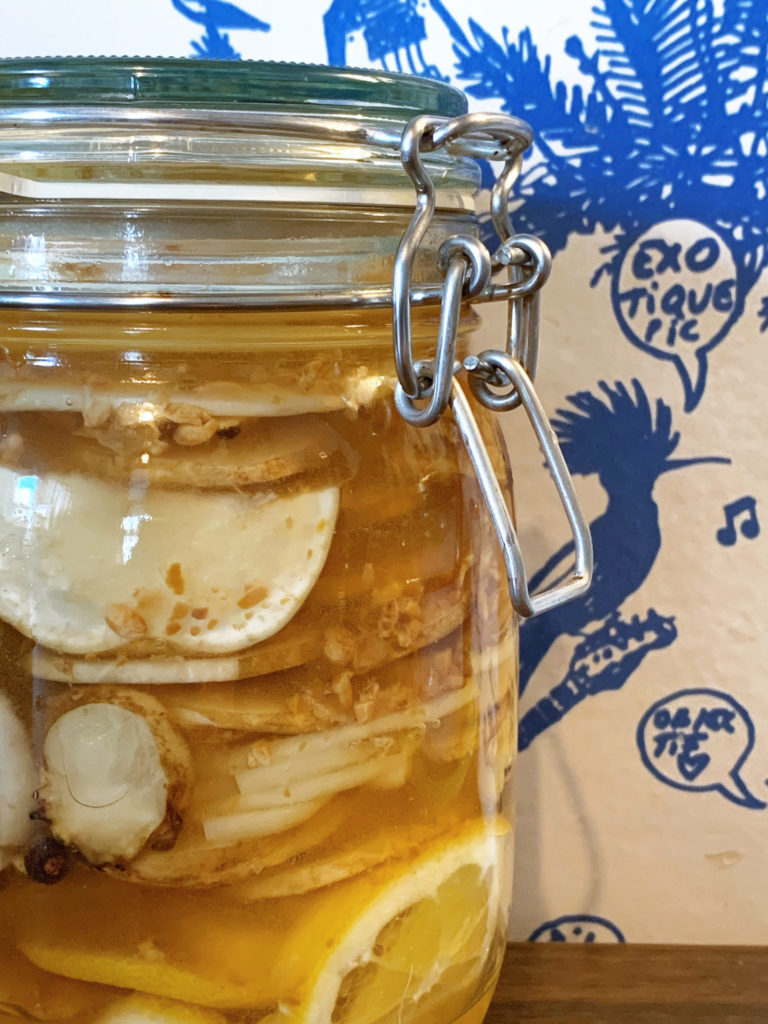Homemade persimmon vinegar is something wonderful. The special taste is defined by the characteristic fruity sweetness and the gentle, nuanced acidity that develops during fermentation. This vinegar can be a refreshing drink, refined with a drizzle of honey for everyday indulgence. Or a fine marinade for fish or vegetables and a stable base for salad dressings with a refined aroma.
Jump to recipeIn Korean and Japanese cuisine, persimmon vinegar is a traditional condiment, food ingredient and beverage base. And as an ingredient in cocktails, it is a culinary highlight! The purest persimmon vinegar is made exclusively from ripe persimmons using acetic acid fermentation.
Which type of persimmon is suitable for making persimmon vinegar?
The hachiya persimmon usually has an elongated shape, often described as heart-shaped and resembling a very plump Roma tomato, whereas the fuyu variety is round and squat. Both varieties can be used to make vinegar, but persimmons with more tannic acid give a better result. Hachiya is the more astringent of the two varieties presented. Persimmon vinegar made from meoksi persimmons, a Korean variety with small, very sweet fruits with a high tannin content, was added to the Ark of Taste's catalog of historic foods in 2014 and tastes fabulous.



What is important when making vinegar?
The vinegar bacteria, acetobacter by name, like alcohol, heat and oxygen.
- To make good fruit vinegar, alcohol is first produced from the fruit. The alcohol content of the brew to be fermented should be between 5 and 9% to achieve the best result.
- The ambient temperature in which the vinegar is produced should be between 21-30°C. Acetobacter likes it warm.
- And Acetobacter needs oxygen! Daily stirring ensures good aeration, as does the cloth covering the container. Vinegar fermentation usually takes place over a period of around 3 to 4 weeks.



Zero Waste
Oh yeah! There are also a few zero waste ideas for this ferment.
The leftover pulp can be used as a bed to pickle vegetables, similar to Japanese nukazuke. To do this, the vegetables are slightly dried beforehand to draw out the water and salted a little. The sweet and sour puree is also great as a filling for onigiri or jumeokbap!
Positive health benefits of persimmon vinegar
Scientific studies have shown that persimmon vinegar has a pronounced antioxidant effect. The results suggest that the consumption of persimmon vinegar can reduce the risk of heart disease.
In addition, a study conducted at Wakayama Medical University in Japan found that persimmon vinegar could potentially act as an anti-ageing agent. It exerts anti-obesity and anti-inflammatory activities. Due to its ability to prevent or at least slow down cell damage caused by free radicals, persimmon vinegar could have a positive effect on the ageing process. These results open up promising prospects for the development of anti-ageing strategies based on persimmon vinegar.
Scientists at the Guangdong Academy of Agricultural Sciences have also discovered that real persimmon vinegar from persimmon fruit has the ability to protect our cells from harmful oxidative stress. This stress occurs when harmful molecules, known as free radicals, take over in our bodies. Research shows that persimmon vinegar protects cells from this danger by activating a protective mechanism. Polyphenols play a decisive role here. They act as a kind of protective shield and help to reduce the harmful effects of free radicals.
It is important to note that additional studies are needed to gain a full understanding of the potential benefits and applications of persimmon vinegar.
Sources
Kanae Mure, Tatsuya Takeshita, Ikuharu Morioka, Mikio Arita: Effects of kakisu (persimmon vinegar) on plasma antioxidant power and urinary 8-isoprostane level
Bo Zou, Gengsheng Xiao, Yujuan Xu: Persimmon vinegar polyphenols protect against hydrogen peroxide-induced cellular oxidative stress via Nrf2 signalling pathway









Hi,
ich habe wie beschrieben, wie beschrieben geschichetet.
Allerdings tritt aus meinen Kakis kein Saft aus, sondern es sieht so aus, als würde sich Schimmel bilden.
Wie kann ich das, das nächste Mal umgehen?
Grüße
Hej Marie,
kann es sein, dass die Kakis noch nicht reif waren? Und täglich rühren ist sehr wichtig, das macht die Früchte weicher. Alles, was schimmelt, muss entsorgt werden.
Gutes Gelingen!
Katsu
Hallo, was ist das für ein Glas, es ist so schön gerade? Danke …
Hej Frieda, das Glas habe ich bei IKEA gekauft.
Hallo, wann hört man auf die Kakis umzukehren?
Lg
Hej Dagmar,
nachdem die Essigfermentation begonnen hat, solltest du noch ein paar Tage rühren. Ich höre meistens nach Tag 12 auf, und gegen Tag 14 oder 15 rühre ich dann nochmal. Beobachte deinen Ansatz gut, dann solltest du es selber entscheiden können. Es spricht auch nichts dagegen, konsequent weiter zu rühren – dann entwickelt sich halt keinen Mutter, aber das ist für das Ergebnis auch nicht nötig.
Gutes Gelingen!
Katsu
Danke für die schnelle Antwort 👍
Hallo
du schichtest nur die Früchte in das Glas, kein Wasser dazu???
Liebe Grüsse
Steffi
Hej Steffi,
ich mache Kakisu genau so, wie im Rezept beschrieben. Wenn Wasser dazugehören würde, hätte ich es aufgeschrieben. Schau dir auch gerne nochmal die Photos an.
Gutes Gelingen!
Katsu
Hallo Katsu,
mein Kakiessig hat einen pH-Wert zwischen 3 und 4. Ist das ausreichend sauer? Geschmacklich gefällt er mir ganz gut.
LG, Ursula.
Hej Ursula,
wenn er dir schmeckt, kannst du ihn jetzt abfüllen zum Reifen.
Gutes Gelingen!
Katsu
Hello !
I’ve tried this recipe but no liquid came out of the fruits, and after a few days they started to get black. Then some white mold started to grow on them and I had to throw them away.
Do you know what’s the reason ? I thought that maybe it was because of the temperature (very irregular, around 15° when I was not home and above 20° when I was). What do you think ?
Thank you ! 🙂
Salut Noé,
you need warm temperatures to make alkohol, so 15° C is a bit too low. Also you need to use ripe fruit and stir at least once a day.
I’d suggest you try again next season.
Good luck next time!
Katsu
Hey Katsu,
welche Früchte kann ich denn noch verwenden?
Geht es auch mit Mango, Ananas, Beeren…… etc. ?
Liebe Grüße Dori
Hej Dori,
Kakisu ist Kaki-Essig, da kannst du keine anderen Früchte benutzen. Wenn du Apfelessig machen möchtest, habe ich here eine Anleitung für dich.
Gutes Gelingen!
Katsu
Dankeschön